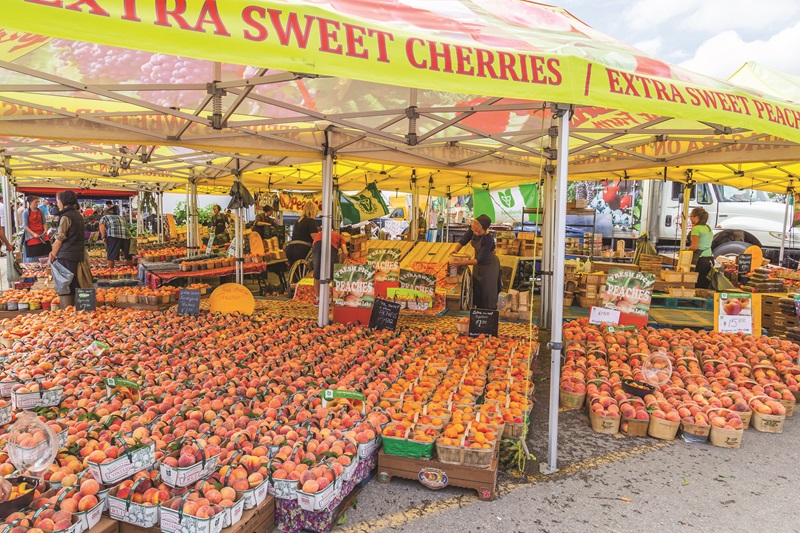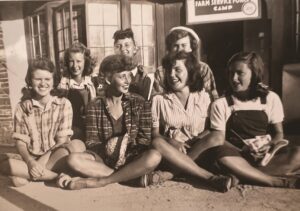Small farm revival
EASTERN AND NORTHERN ONTARIO MENNONITE COMMUNITIES GROW

IF YOU DROVE AROUND RENFREW COUNTY TODAY or any day stretching back to many decades ago, you’d see many underused or abandoned historic farms, typically 100 acres in size. The farmhouse and buildings may be condemned, unoccupied or occupied, and the farmland is often used for hay, with typically some areas left fallow and others partially or completely returned to forest. It’s the same in some other areas of the province as well.
It’s never easy to clear land for farming, but the fields in Renfrew County (northwest of Ottawa and known as the Ottawa Valley) were particularly hard-won. The book Harvest of Stones recounts how immigrant farmers, starting around 1850, “had to cope with the poor soil” of the county and reported an “annual harvest of stones” that had to be carried out by all family members. It was a tremendous amount of work to cut trees and remove both stumps and stones using only human and horse power. Stone fences still abound across the county, an enduring testament to the men, women, and children who freed countless rocks from the soil and piled them along their new fields in order to survive.
This is one reason why, when you ask residents about the Mennonites who have come to the area, you generally get a big smile. “It’s wonderful to see the farms brought back to life,” explains Lee-Ann McCann, who resides near Eganville and has Mennonite neighbours. “For many of us still living here, our ancestors tried farming but gave up after a few generations, so it’s really positive that the Mennonites are reviving this historical and personal connection. I think people also like seeing the industriousness, the family values and the community cooperation. They like seeing the horses out and about. Our neighbours rent our land for hay.”
HISTORY OF EXPANSION
Mennonites trace their roots to the Reformation in Europe 500 years ago, explains Barb Draper, a historian from Elmira, Ontario. “They began moving due to persecution,” she notes. “In the early 1700s, some moved to Pennsylvania and in the early 1800s, a considerable number moved to Ontario. There were several Mennonite communities, including the Niagara peninsula and Markham township, but probably the largest was in what is now Waterloo Region.”
As Tom Neufeld explains, the current movement of Mennonites into areas beyond Waterloo is nothing new. There has been immediate expansion into the nearby counties of Perth, Wellington, and Bruce, but Neufeld (a full-time farmer and stewardship associate at Mennonite Central Committee Ontario) notes that over the last few years, “the Old Order communities are looking for cheap land, and they’ve expanded to different areas of central Ontario. I came upon a significant Old Order group north of Manitoulin Island several years ago, 200 or 300 in population. There’s a bit of a clay belt there.”
In central and northern Ontario, nearby communities with Mennonites now include Mount Forest, Chesley, Massey, Powassan, Matheson, Kinloss, Teeswater, New Liskeard, Sault Ste Marie, Madoc and Lindsay. Ontario Federation of Agriculture (OFA) reports a growing number of Mennonites between Brockville and Mallorytown in Leeds County. There has also been some migration to Michigan.
Neufeld notes that Mennonites “like to be an area where there are good-sized markets for their products, and where they are welcomed. They like to be what you could call secluded but not isolated.”
Today, there is a large spectrum in Mennonite ways of life, from Old Order ‘horse and buggy’ to those who use technologies like computers and cell phones.
RENFREW COUNTY GROUPS
Traditional and more modern Mennonites make their home in Renfrew County.
“We welcome them,” says David Wybou, the County of Renfrew business development officer. “It’s very nice to have a variety of people in the area. It adds to what we experience in our lives. And the more of our land that’s productive, the better, from a food security perspective.”
From an economic perspective, Wybou explains that in October, 2024 he and others from many organizations, including the Ontario Ministry of Agriculture, Food and Agribusiness, hosted the Municipal Economic Development and Planning Forum in Pembroke, the first time it was hosted in eastern Ontario. A farm tour was included to better acquaint participants with the needs of all types of farmers in the county. “We were brainstorming about the Forum in late 2023, and someone suggested that we include a Mennonite farm,” says Wybou. “One of the planners was going out to meet a farmer near Douglas with a large farmgate store and invited me along. I asked the farmer about being included in the tour, and he agreed.”
Wybou adds that on that day, a busload of Germans stopped by. “These tourists love to stop at the Mennonite farms because they can speak their language,” he says. “And those tour buses stop in other places in the County to spend money as well. This is great, from an economic development perspective, as are the Mennonite businesses and the products available for sale. Yes, their purchase of farms here is driving up the selling prices, but that’s a very positive thing for sellers.”
Mark Reusser, a Mennonite farmer and Zone 9 OFA director for Waterloo/Wellington, notes that Mennonites strive to almost always run a business on the farm, usually related to farming. “This is to bring in income, but also, work is considered good,” he explains. “It is important to this way of life. Everyone contributes. Some Mennonites get jobs off the farm as there just isn’t enough work on the farm for everyone.”
No matter where they are, Mennonite farms remain traditional mixed farms. They raise poultry, pigs, and cattle and grow hay, oats, and barley, with additional large market garden operations. Those outside the southern Ontario region, says Neufeld, grow shorter-season grain crops with varieties that “have come a long way.” Some Mennonites also sell fruit, fruit trees, plants, shrubs, decorative pumpkins and gourds, baked goods, and more at markets or the farm gate.
It’s clear there are many benefits of Mennonite expansion in Ontario. For his part, Reusser is of the view that “it invigorates the countryside to have farms look like farms again. It’s nice to have the countryside look like it did 50 or 100 years ago.” •

























